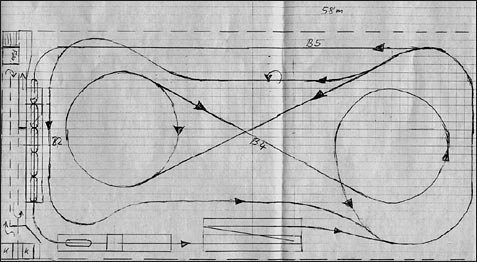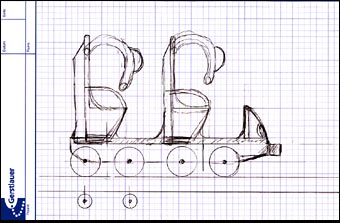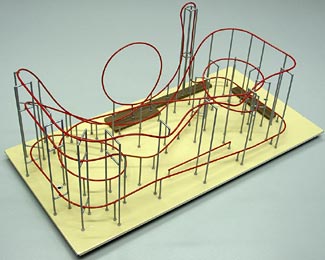 |
|
The first sketch of Typhoon made by Mr.
Gerstlauer |
|
"Those are ideas you get on a sunday afternoon",
Hubert Gerstlauer tells us while looking at the model of Typhoon.
The name-giving founder and owner of the Gerstlauer Elektro GmbH
browses through a cram-full folder and picks a sheet: "This
was my first sketch".
There is a neat ground plot depicted on that checkered
piece of paper. "Here you can see the tower and the vertical
loop". Following a line in the direction of a small arrow,
doubtlessly the layout of the steel structure that is almost
completely assembled on the site becomes obvious - even though it
is built mirror-invertedly.
The strategic philosophy of Hubert Gerstlauer is clear:
A roller coaster should enthuse its riders and lead them to new
extremes, but at the same time the construction should be
manageable and with low error potential. Regarding the development
of roller coasters this is a delicate venture, and many companies
had to pay their tribute (see "The
history of Gerstlauer"). |
 |
|
Looking through the vertical loop, the three
other inversions are viewable |
|
So Hubert Gerstlauer already defined the construction
details for the project Euro-Fighter with his first
principle sketches. "I knew from the beginning that I would
use a chain for the lift, because we have our experience in that
field". Other technologies like a cable lift haven´t
even been taken into consideration. But this is only one example
among many others. Directly after he had the idea for the tower
lift Gerstlauer has put it on paper. "In the
beginning a retractable track segment should bring the cars in a
vertical position to climb up the tower, but I soon realized that
a bent transition would be the better choice", he describes
his thoughts. The cars are picked up by a pusher that is connected
to the chain. They are brought to the top of the tower where they
negotiate the round end with its small radius and then whizz
towards mother earth. The drop is constructed in a way
that the cars dive down the tower steeper than vertical without
the need of any brakes, making it a unique free fall experience.
But why of all things in an angle of 97 degrees? The answer of our
dialog partner is simple: "That´s just the way it arose!"
 |
 |
|
Comparison: The first sketch of the car and
the final version at BonBon Land |
|
The level of detail of his freehand sketches is really amazing.
Up till today nothing changed in the positions of the block brakes
and the outline of the layout, even the cash desk with the waiting
area and the photo booth are recognizable. "My first thought
was a transportable looping coaster", Gerstlauer
remembers, "so the determining aspects were the footprint and
the capacity." He prefers a strict and goal-oriented
proceeding on the basis of elementary parameters: Single cars
cruise on a rectangular and even a little square-edged layout with
multiple layers. The tower and the following vertical loop are
determining characteristics, afterwards the ride consists of
drops, sharp bends and helices.
The fact that the coaster was originally conceived for traveling
fairs can be seen in constructive details like the continuous
sole, the conical plug system and the support structure. But there
is another point: The visitor of a fair pays for every ride and
has to be convinced and satisfied each time. So the front towards
the spectators is ruled by a very open design. The dominant and at
the time of the first sketches completely novel 90° tower
lift draws everyone´s attention. Looking through the
following vertical loop it pales two heartline rolls
like a giant frame. The same holds for the fourth inversion,
another heartline roll, that leads directly into a downwards helix
and wasn´t included in the first sketches. Looking at the
model the coaster seems to be designed a little too geometrically,
but standing in front of it you exactly see the effect Hubert
Gerstlauer intended.
The entrepreneur continues browsing and shows us first drafts of
the supports, the installation of the track at the tower and the
track profile. Like at his other coasters he wanted to use the
track with the two tubes and the transverse strut. He then brings
up the first sketches of the cars: "There would have been no
way to negotiate the small radius at the top of the tower with a
train, so I decided to use single cars." To reach the desired
capacity of 1400 riders per hour he divided the 670 meters of
track into a larger number of blocks and doubled the cars´
capacity by placing four riders in a row. In addition, there is a
second pusher assembled to the chain to keep the rate of three
cars per minute. The next car can be pushed up as soon as the
first one dives down the tower.
Gerstlauer focussed on a spatious design when creating
the cars, making it easy to reach the seats for the riders - a
basic requirement for fast changes. Even the first sketches with
the small and rounded front were exactly realized. But this doen´t
only apply to the optical features, even the technical aspects
were clearly defined in the early stages. Instead of using two
axes, the four wheel configurations are hung independently. In
addition, the cars consist of two parts like in the first
specifications. |
|
Despite their high level of detail the first sketches
disappeared in the drawer, no-one thought of realizing this ride.
But three years ago some drafts of an Italian company were printed
in a German magazine for fairs and theme parks, showing a similar
concept for the traveling market. There was even a showman
mentioned who wanted to buy the attraction, so Gerstlauer
became alert and pushed the project Euro-Fighter. Without
regarding the exact statics and dynamics, his nephew finalized the
designs in January 2001. He created a sheer plan using the CAD
system Auto CAD to shape the pallet and the sole. They
carry the the track of the station, the tower, the vertical loop
and the other supports of the ride. In addition, a developed view
was made. These two graphs together describe the layout in a way
that a three-dimensional model could be produced. It was presented
on the world´s largest tradeshow for the amusement business,
the IAAPA, in November 2001, and two months later during
the European counterpart Interschau in Düsseldorf.
 |
|
The mirror-invertedly model of Typhoon |
|
Das filigrane, aus dünnen Stahlstreben gelötete Modell
sorgte bei den Parkverantwortlichen für einige
Aufmerksamkeit, aber nicht beim favorisierten
Schaustellerpublikum. "Zwar gab es einen Schausteller, der an
einer Realisierung sehr interessiert war", erinnert sich Hubert
Gerstlauer, "doch dieser wollte für einen gewissen
Zeitraum die Exklusivrechte am Euro-Fighter für sich
beanspruchen." Für den Unternehmer eine völlig
indiskutable Forderung, schließlich zeigten diverse Parks
intensives Interesse. Unter ihnen war auch Jacky Schoepen,
Juniorchef des Bobbejaanlandes, der eher zufällig am
Stand vorbeilief und auf den Hersteller und das Modell aufmerksam
wurde. Für Gerstlauer war die Präsentation ein voller
Erfolg: Im Juni 2001 stand die Vertragsunterzeichnung für den
Prototypen an.
 |
|
Looking from the top |
|
This filigree, made of thin steel wire, hasn´t aroused the
intended attention among the showmen, but very well among the park
managers: "There is a showman who was really interested in
this attraction", Hubert Gerstlauer remembers, "but
he wanted the exclusive rights of Euro-Fighter for a
specific period." This demand was absolutely out of the
question for the entrepreneur, because some amusement park
managers also showed interest in the ride. One of them was Jacky
Schoepen, junior director of Bobbejaanland, who
coincidentally passed the booth and became aware of the model and
the manufacturer. For Gerstlauer this presentation was a
huge success: In June 2001 the contract for the prototype was
signed. A family park in Denmark decided to buy this concept with
the new vertical lift and drop, and in the first season the park
could announce a boost in attendance of 18 percent. But for this
coaster the layout was completely redefined, the ride would have
been to wild for the visitors. That won´t be the case at Bobbejaanland:
Jacky Schoepen´s demands on a new looping coaster
were fully satisfied by this layout (see "Looping
Star´s last ride"). So the contract was signed
in November 2002.
This was the chance to implement the initial designs. The ride
exactly fitted into the space the Looping Star occupied in
the Belgian park, and the provided sole turned out to be a big
advantage for Bobbejaanland. The park is built on a former
swamp area, so the ground is very soft and casting a foundation
for every support beam would be very laborious and costly. The
sole, a mesh of steel profiles, spreads the load continuously on
the baseplate which is far cheaper to build. This ground plane as
well as the station building are self dependently built by Bobbejaanland.
The rest of the ride, which will have a space theme, will be
delivered by Gerstlauer turnkey ready.
By the way: The announcement of the portable looping coaster
that let Gerstlauer push the project was realized indeed.
Exacly five months after Vild Svinet, the prototype in
BonBon Land, the idiosyncratic construction "Cool
& Fresh" debuted on October 2003 on a fair in Eastern
Germany with a delay of two years. Hubert Gerstlauer was
faster once again...
Typhoon - A roller coaster emerges will be continued. Read
more on the construction, production and assembly of this looping
coaster in our next articles. |

